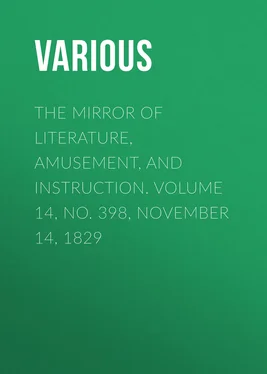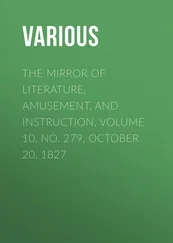Various - The Mirror of Literature, Amusement, and Instruction. Volume 14, No. 398, November 14, 1829
Здесь есть возможность читать онлайн «Various - The Mirror of Literature, Amusement, and Instruction. Volume 14, No. 398, November 14, 1829» — ознакомительный отрывок электронной книги совершенно бесплатно, а после прочтения отрывка купить полную версию. В некоторых случаях можно слушать аудио, скачать через торрент в формате fb2 и присутствует краткое содержание. Жанр: foreign_antique, periodic, Развлечения, foreign_edu, на английском языке. Описание произведения, (предисловие) а так же отзывы посетителей доступны на портале библиотеки ЛибКат.
- Название:The Mirror of Literature, Amusement, and Instruction. Volume 14, No. 398, November 14, 1829
- Автор:
- Жанр:
- Год:неизвестен
- ISBN:нет данных
- Рейтинг книги:4 / 5. Голосов: 1
-
Избранное:Добавить в избранное
- Отзывы:
-
Ваша оценка:
- 80
- 1
- 2
- 3
- 4
- 5
The Mirror of Literature, Amusement, and Instruction. Volume 14, No. 398, November 14, 1829: краткое содержание, описание и аннотация
Предлагаем к чтению аннотацию, описание, краткое содержание или предисловие (зависит от того, что написал сам автор книги «The Mirror of Literature, Amusement, and Instruction. Volume 14, No. 398, November 14, 1829»). Если вы не нашли необходимую информацию о книге — напишите в комментариях, мы постараемся отыскать её.
The Mirror of Literature, Amusement, and Instruction. Volume 14, No. 398, November 14, 1829 — читать онлайн ознакомительный отрывок
Ниже представлен текст книги, разбитый по страницам. Система сохранения места последней прочитанной страницы, позволяет с удобством читать онлайн бесплатно книгу «The Mirror of Literature, Amusement, and Instruction. Volume 14, No. 398, November 14, 1829», без необходимости каждый раз заново искать на чём Вы остановились. Поставьте закладку, и сможете в любой момент перейти на страницу, на которой закончили чтение.
Интервал:
Закладка:
Various
The Mirror of Literature, Amusement, and Instruction / Volume 14, No. 398, November 14, 1829
THE NATURALIST
Castles, cathedrals, and churches, palaces, and parks, and architectural subjects generally, have occupied so many frontispiece pages of our recent numbers, that we have been induced to select the annexed cuts as a pleasant relief to this artificial monotony. They are Curiosities of Nature; and, in truth, more interesting than the proudest work of men's hands. Their economy is much more surprising than the most sumptuous production of art; and the intricacy and subtlety of its processes throw into the shade all the contrivances of social man: a few inquiries into their structure and habits will therefore prove entertaining to all classes of readers.
1. THE PRAYING MANTIS
The Mantis is a species of cricket, and belongs to the Hemiptetera, or second order of insects. Blumenbach 1 1 Manual, translated by Gore.
enumerates four varieties:—1. the Gigantic, from Amboyna, a span long, yet scarce as thick as a goose-quill, and eaten by the Indians. 2. Gonglyodes, from Guinea. 3. the Religious Mantis, or Praying Cricket. 4. Another at the Cape, and considered sacred by the Hottentots. The cut represents the third of these varieties.
It mostly goes on four legs, holding up two shorter ones. The hind legs are very long; the middle ones shorter. It is sometimes called the Dried and Walking Leaf , from the resemblance of its wing covering, in form and colour to a dry willow leaf; it is found in China and South America, and in the latter country many of the Indians believe that Mantes grow on trees like leaves, and that having arrived at maturity, they loosen themselves, and crawl or fly away.
Mr. T. Carpenter 2 2 Gill's Technological Repository, vol. iv. p. 208.
has recently dissected the head of this species, in which he found large and sharp cutting teeth; also strong grinding ones, similar to those in the heads of locusts: the balls at the ends fit into sockets in the jaw. The whole length of the insect is nearly three inches; it is of slender shape, and in its sitting posture is observed to hold up the two fore-legs slightly bent, as if in an attitude of prayer, whence its name; for this reason vulgar superstition has held it as a sacred insect; and a popular notion has often prevailed, that a child, or a traveller having lost its way, would be safely directed, by observing the quarter to which the animal pointed, when taken into the hand.
Its real disposition is, however, very far from peaceable: it preys with great rapacity on smaller insects, for which it lies in wait, in the first mentioned posture, till it siezes them with a sudden spring, and devours them. It is, in fact, of a very ferocious nature; and when kept with another of its own species, in a state of captivity, will attack its fellow with the utmost violence, and persevere till it has killed its antagonist. Roësal, a naturalist, who kept some of these insects, observes, that in their mutual conflicts, their manoeuvres very much resemble those of hussars fighting with sabres; and sometimes the one cleaves the other through, or severs the head from its body with a single stroke. During these engagements the wings are generally expanded, and when the battle is over, the conqueror devours his vanquished foe.
Among the Chinese, this quarrelsome disposition in the Mantis, is converted to an entertainment, resembling that of fighting-cocks and quails: and it is to this insect that we suppose the following passage in Mr. Barrow's Account of China , alludes:—"They have even extended their inquiries after fighting animals into the insect tribes, and have discovered a species of locusts that will attack each other with such ferocity, as seldom to quit their hold without bringing away at the same time a limb of their antagonist. These little creatures are fed and kept apart in bamboo cages; and the custom of making them devour each other is so common, that during the summer months, scarcely a boy is to be seen without his cage of locusts." 3 3 Travels in China.
The country people in many parts of the continent, look upon the religious Mantis as a divine insect, and would not on any account injure it. Dr. Smith, however, informs us, that he received an account of this Mantis, that seemed to savour little indeed of divinity. A gentleman caught a male and female, and put them together in a glass vessel. The female, which in this, as in most other insects, is the largest, after a while, devoured, first the head and upper parts of her companion, and afterwards the remainder of the body. 4 4 Tour on the Continent.
Roësel, wishing to observe the gradual progress of these creatures to the winged state, placed the bag containing the eggs in a large enclosed glass. From the time they were hatched they were very savage. He put various plants into the glass, but they refused them, in order to prey upon each other. He next tried insect food, and put several ants into the glass to them, but they then betrayed as much cowardice as they had before done of barbarity; for the instant the Mantes saw the ants, they attempted to escape in every direction. He next gave them some common house flies, which they seized with eagerness in their fore claws, and tore in pieces; notwithstanding this apparent fondness for flies, they continued to destroy each other. Despairing at last, from their daily decrease, of rearing any to the winged state, he separated them into small numbers, in different glasses; but here, as before, the strongest of each community destroyed the rest. He afterwards received several pair of Mantes in the winged state, which he separated, a male and female together, into different glasses; but they still showed a rooted enmity towards each other, which neither age nor sex could mitigate. The instant they came in sight of each other, they threw up their heads, brandished their fore-legs, and each waited the attack. They did not, however, long remain in this posture; for the boldest throwing open his wings with the velocity of lightning, rushed at the other, and often tore it in pieces.
The last mentioned species is the supposed idol of the Hottentots; the person on whom the adored insect happens to light, being considered as favoured by the distinction of a celestial visitant, and regarded ever after as a saint.
2. BRANCHED STARFISH
This is the most curious species of Asterias, or Sea Star. They are crustaceous animals, and many of the species are noxious to oysters, others to cod-fish, &c.
The species represented by the Cut, has five rays, dividing into innumerable lines or branches. The mouth is in the centre, armed with sharp teeth, which convey the food into the body, and from this mouth goes a separate canal through the rays. These the animal, in swimming, spreads like a net to their full length; and when it perceives any prey within them, draws them in again with all the dexterity of a fisherman. It is an inhabitant of every sea; and is called by some the Magellanic starfish and basketfish . When it extends its rays fully, it forms a circle of nearly three feet in diameter; and Blumenbach tells us that 82,000 extremities have been reckoned in one of these curious creatures.
In another species of the Asterias, the power of reproduction is particularly-striking. "I possess one," says Blumenbach, "in which regeneration had begun of the 4 rays that had been removed out of 5 which it originally possessed." We have picked up on the seashore many of the species to which he alludes, and they are much less rare than that in the Cut. Of the latter we have seen three or four specimens—one in a small Museum at Margate, and, we think, two others in the Museum in the Jardin des Plantes , at Paris. They resemble a bunch or knot of dark brown small rope or cord.
Читать дальшеИнтервал:
Закладка:
Похожие книги на «The Mirror of Literature, Amusement, and Instruction. Volume 14, No. 398, November 14, 1829»
Представляем Вашему вниманию похожие книги на «The Mirror of Literature, Amusement, and Instruction. Volume 14, No. 398, November 14, 1829» списком для выбора. Мы отобрали схожую по названию и смыслу литературу в надежде предоставить читателям больше вариантов отыскать новые, интересные, ещё непрочитанные произведения.
Обсуждение, отзывы о книге «The Mirror of Literature, Amusement, and Instruction. Volume 14, No. 398, November 14, 1829» и просто собственные мнения читателей. Оставьте ваши комментарии, напишите, что Вы думаете о произведении, его смысле или главных героях. Укажите что конкретно понравилось, а что нет, и почему Вы так считаете.












